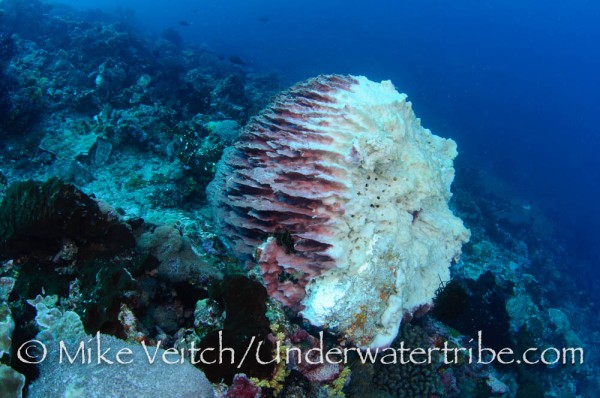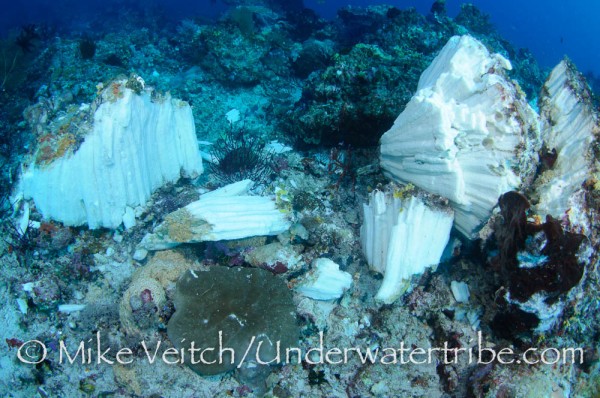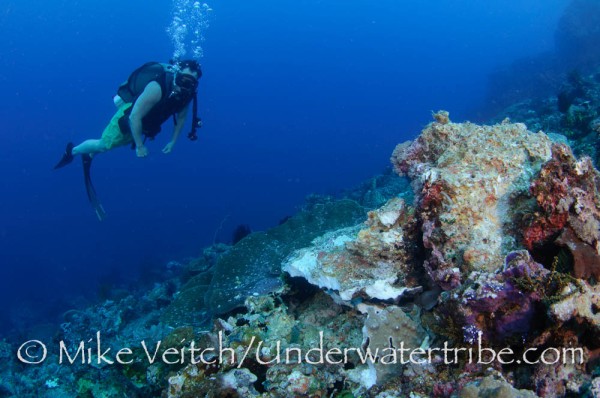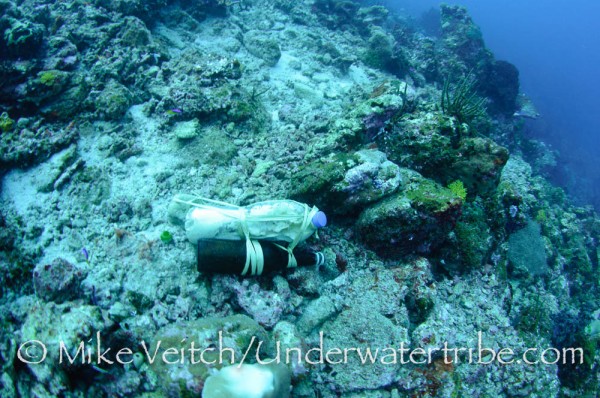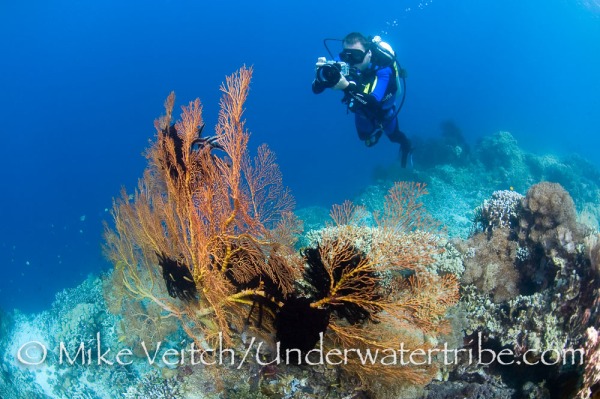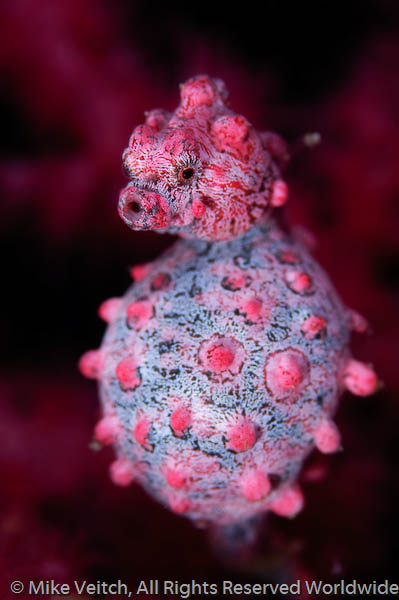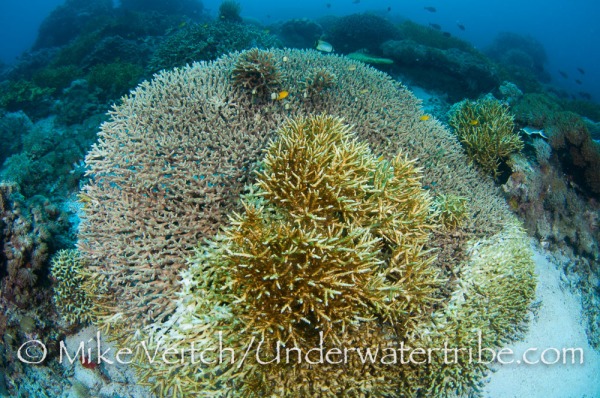Blast Fishing and Its Results
A word of warning, some of the images in this post are difficult to look at, if you don’t like to see images of destroyed reef please don’t look any further.
I find it sad that I need to preface a post like this, but unfortunately, its a fact of life these days in many areas around the world. There are many reasons why different people in different countries participate in “dynamite fishing” but I won’t get into the economical, cultural or population based aspects of it, instead the goal of this post is to show the damage that blast fishing can have on a coral reef. A lot of people are unaware of the reality of illegal fishing, and nothing can describe the damage better than a series of photos to go along with a short article. On a recent dive trip, I was swimming along a beautiful reef, one of my favourite sites in this particular island group, when I began to notice evidence of bomb damage. The first thing I happened to notice was 5 or 6 really large morays all within a few metres of one another; as this is a strange occurrence, I started looking around the area to see why this would be? Large morays in this area don’t usually congregate unless there is an unusual food supply around. Sure enough, looking at the hard coral, I noticed several cracks in the coral heads. A few metres further on there was a large patch of rubble that was obviously bombed. Not only was it bombed, it was done recently, either earlier that day or the day before. The reason I could tell it was fresh was due to the fact the broken areas were bright white and the presence of several dead and shredded fusiliers under the coral heads! Sadly, I had found the reason for the presence of the large morays: they were attracted by the smell of the dead fish on the bottom that were obviously victims of illegal dynamite fishing. Thankfully, there was only one small area of the reef affected, in fact, many of my fellow divers were unaware that they were looking at dynamite fishing and were surprised to learn what caused the damage.
Two weeks later, I returned to this same remote island group with another set of guests; before diving this site, I briefed them about the previous damage we had encountered and told them to expect a small area of damage midway through the dive. After jumping in and enjoying a great start with lots of soft coral and small tropical fish, we came around the corner to where I expected to see a small patch of damage; only to be confronted with wide scale destruction! What had been a few square metres of damage two weeks earlier was now a patch of devastation about the size of a soccer/football field! Obviously our friendly neighbourhood reef bombers had been back during our absence and continued where they had left off. Not only was the reef in terrible condition, there was actually one unexploded bomb lying on the bottom! One of my fellow divers pointed it out to me and of course I immediately wanted to take a photo of it, however, as I got closer I felt a sense of trepidation as I don’t know too much about these devices. Obviously, I was a bit apprehensive that it could explode at anytime, maybe even my strobes would set it off? So I turned those off 🙂 I didn’t get too close, but I managed to take a photo of it and then made my way out of the area. We didn’t go back to that reef again due to the instability of this item.
Basically, a “fish bomb” is a mix of kerosene and fertilizer that is stored in a discarded beer or soft drink bottle and then thrown into the sea where it sends out a large shockwave. This shockwave kills all fish in the area including those in the water column such as fusiliers and surgeonfish, as well as those on the reef like butterflyfish and damsels. Some of the fish float to the top where the fishermen simply scoop them up with a net, but the vast majority sink to the bottom due to damage to their swim bladders; these fish are not so easily collected and therefore go to waste. The high level of dead and wasted fish and the severe damage to the coral means that a bombed area of reef is no longer a productive part of the ecosystem, a very inefficient method of fishing indeed! Sadly, there was not a lot we could do as this remote location is far from any patrols and regular enforcement doesn’t take place.
Enough about trying to describe it, I think the best way to understand dynamite fishing is to show the damage in photos:
Reef Respect
Here is another of my articles from a few years ago in Scuba Diver Australasia magazine, this one is entitled “Reef Respect” and its about the importance of photographers and divers respecting the corals and marine life while underwater. Some of the accompanying photos are tough to look at.. You can also find this at Wetpixel
Reef Respect
When I first started diving for a living the number of divers with a camera in their hand were relatively few and far between. Serious divers would carry a Nikonos V or video camera while those who were after a bit of fun would often have a Sea and Sea MX10 at their disposal. However, with the recent explosion of digital photography, it seems everyone now has a camera of some description; from small compacts to multi strobed housed SLR monstrosities. This is great in some respects, as the art of underwater photography has really blossomed and these images are being shown in more and more mainstream media helping to raise awareness of our fragile eco-system. However, as popular as photography has become it’s having an inverse affect on what we love; the reefs of the world. As we should practice what we preach, here are some guidelines the conscientious photographer should follow in order to protect the underwater environment.
Placement
As photographers, we spend a lot of time with a subject looking for the perfect angle and trying to capture the essence of that animal. Whereas the average diver often gives only a cursory glance and moves onto the next subject. As we spend an inordinate amount of time in one place, we have to be more aware of our positioning and surroundings than everyone else. Unfortunately, many careless photographers don’t care about their surroundings and zero in entirely on their subject. Not only does this give photographers a bad name, but it destroys the reef and reef life around them. Fortunately, there is a simple solution to this: look around before you settle in for a photograph. Be sure that your fins will not be resting in an anemone or sponge, keep some air in your BCD in order to keep your torso off the ground, have your “danglies” clipped onto you, and use a finger to keep yourself steady. It is far easier to keep your balance if you use your left hand as a steadying tool rather than on the camera. By looking around before you settle in for a photo, it’s easy to find a bare patch or rock in which to support yourself. Don’t just stick your hand out to grab the closest object if you find yourself losing buoyancy! Not only could you damage a delicate coral, you may stick yourself on a poisonous creature. And of course nothing ruins a photo more than the off balance diver who tries to skull their hands to keep off the bottom, this results in stirring up backscatter particles in front of the lens. When you are finished photographing your subject, take a breath and allow yourself to float away from the bottom before you start kicking your fins. Trying to kick off the bottom will result in a major dust cloud and broken bits of coral flying everywhere.
Current
In wide angle photography there is another dilemma that comes into play: current.
It’s not easy to keep yourself in place taking a photo if you have current pushing you along. If you find a subject along a current swept wall there’s an easy way to stop yourself and get that photo. Simply turn around and face into the current and steady yourself with a one or two finger grip on a bare patch on the wall. By doing so, you won’t have to fin a lot and therefore not kick any fragile sea-fans or soft corals. Once you are finished, push yourself away from the wall with that hand, don’t kick with your fins in an attempt to turn around! This will only result in damaging the marine life around you.
Getting Sticky With It
Cameras aren’t the only recent development that have gained in popularity the last few years; “pokey sticks” a type of stainless steel rod, are now just as commonly seen as cameras. When used appropriately, these are a great asset to photographers and non photographers alike, as they allow the user to hold themselves away from the bottom with one hand instead of grasping onto coral and other fragile organisms. But, used in the wrong hands, these instruments can be a weapon of destruction. Many talented dive guides are able to use these tools in a professional manner by ruffling the dirt in front of a mantis shrimp hole or tapping on a rock to get the attention of an octopus. There is no problem with this, as long as it’s done in a gentle manner. However, many regular divers and photographers have now taken it upon themselves to use their “sticks” to try to manipulate the critters on the reef. Oftentimes, it’s not done in a gentle way and photographers are the guiltiest species of all as they try to pry a mimic octopus out of its hole for a once in a lifetime shot. Photographers are also guilty of tempting dive guides to do this in exchange for a healthy tip. Unfortunately, this scenario is playing out more and more often in popular diving spots and its effect can be seen by dwindling numbers of creatures on dive sites. As responsible photographers we can have a great influence over the behaviour of others, by showing an example and not doing it ourselves and encouraging over zealous dive guides not to do it for our benefit as it’s not acceptable behaviour.
Patience!
Don’t rush in to take photos or prod a mantis shrimp with a stick, as your intended subject will only retreat back into its hole. Instead of trying to force subjects into certain behaviour, it’s far better to display patience with marine life and allow them to act naturally. By watching your subject from a comfortable distance, you can gauge their natural patterns and behaviour. It will also give them a chance to get used to your presence and gradually allow you to get closer. You can then move forward and hopefully get that winning shot. In this vain, also remember that you can’t disturb or potentially harm animals in an attempt to add the perfect photo to your portfolio. Deliberately bending seafans to get a better angle of a pygmy seahorse or pulling the arms off of a crinoid to shoot a shrimp are completely unacceptable behaviour for everyone.
Courtesy is Everything
It’s not only the marine life that should be treated with courtesy but your fellow divers and photographers as well. As most dive resorts practice “group diving”, odds are you will be diving with other photographers and divers when you are underwater. In order for everyone to have a successful dive, it’s common courtesy to take a few photos of a subject and then move along so others also get a chance. If it’s a subject that you have a particular desire to spend a lot of time with, wait until everyone else has taken their photos and then come back to shoot it again. Also, be careful when you leave a subject you have been shooting. Be sure that you don’t disturb it when you leave in order to give your fellow divers a chance to shoot it as well.
Flashy Behaviour
Do you hate it when someone comes up to you and takes your photo with a bright flash? This is the same feeling that fish and crustaceans feel when photographers barrage them with light. The sensitivity of the optical nerve of organisms that live underwater is far greater than humans due to living in a dim environment. Therefore, the effect of bright strobes is felt much more so by the oceans’ inhabitants. In order to lessen your impact upon marine life it’s wise to limit the amount of photos you take of any particular subject. Not only will you be taking photos of that cute little pygmy seahorse, everyone else on the dive will too! By being patient and waiting for your subject to get in position before firing off a shot, you will have far less impact on it than those who “machine gun” image after image in order to capture one perfect shot. The sea life will thank you for it.
At the end of the day, we all love photography and can’t wait to get back in the water after our latest trip has ended. Unfortunately some of us have returned to places we have been in the past only to find the inhabitants we interacted with are no longer there! Although this may be caused by natural events such as storm damage or coral bleaching, there is no denying that popular dive locations suffer from a large amount of diver damage as well. By practicing considerate and safe photography you can lessen your impact and footprint on the coral reef. If everyone does their part, by following the guidelines above, we will all benefit in the long run with a healthy and happy underwater world.
Old Interview on You Tube
I found an interview of me from Manta Ray Bay Hotel in Yap, I don’t remember who shot the interview though! Check it out, the manta footage is rather impressive even if I say so myself..
Environmental Impact Photos
 Over the years, I have seen a lot of damage done to reefs all throughout the Pacific, from huge storms to coral bleaching to crown of thorns starfish, and my least favourite: blatant destructive fishing by mankind. Whenever I encounter damaged reefs it makes me both sad as well as angry, especially when I know the damage is being done by dynamite fishing. This sort of destruction is especially prevalent in the Indo-Pacific, but it’s certainly not localized to that region as many areas of the world suffer from this and other forms of non-sustainable fishing practices. Shark finning is the big environmental cause these days and there is a lot of publicity for it (and for good reason as its an appalling practice) but there are other dire impacts happening out there that don’t see the same amount of publicity they deserve. The atrocities being done to mantas (as well as other rays) and dynamite fishing are two issues that really need a lot more publicity in order to raise their profile with the public. One of the ways to do this is to publicize the damage that such practices can inflict upon the underwater world. This is the reason I am introducing a new gallery on my Photography site called Environmental Issues. In the past, I have always included these images within other “geographical” galleries but now I think I should showcase the horrible things that we humans do to our planet. Not all of the photos are from direct human impact, I will also include reefs damaged by typhoons etc in this gallery. Sadly, this gallery will continue to grow as coral reefs the world over continue to dwindle due to the pressure we are putting on them. On a brighter note, I will also add positive impact photos to this gallery as well when I am able to document people working to sustain the marine ecosystem.
Over the years, I have seen a lot of damage done to reefs all throughout the Pacific, from huge storms to coral bleaching to crown of thorns starfish, and my least favourite: blatant destructive fishing by mankind. Whenever I encounter damaged reefs it makes me both sad as well as angry, especially when I know the damage is being done by dynamite fishing. This sort of destruction is especially prevalent in the Indo-Pacific, but it’s certainly not localized to that region as many areas of the world suffer from this and other forms of non-sustainable fishing practices. Shark finning is the big environmental cause these days and there is a lot of publicity for it (and for good reason as its an appalling practice) but there are other dire impacts happening out there that don’t see the same amount of publicity they deserve. The atrocities being done to mantas (as well as other rays) and dynamite fishing are two issues that really need a lot more publicity in order to raise their profile with the public. One of the ways to do this is to publicize the damage that such practices can inflict upon the underwater world. This is the reason I am introducing a new gallery on my Photography site called Environmental Issues. In the past, I have always included these images within other “geographical” galleries but now I think I should showcase the horrible things that we humans do to our planet. Not all of the photos are from direct human impact, I will also include reefs damaged by typhoons etc in this gallery. Sadly, this gallery will continue to grow as coral reefs the world over continue to dwindle due to the pressure we are putting on them. On a brighter note, I will also add positive impact photos to this gallery as well when I am able to document people working to sustain the marine ecosystem.
The Gallery can be found here: Environmental Issues
Gallery in Sanur, Bali
 I am proud to announce that a selection of my images are now on display in the Liquidmocean Gallery in Sanur, Bali, Indonesia. Founded by photographer Mark Thorpe of Liquidmocean the gallery houses a selection of water inspired images such as water droplets, surfing and wave photography, and of course my underwater images. If you are in Bali please stop by the gallery which is located in the Six Point Building just off the Bypass beside McDonalds. All of the canvas and fine art prints are available for sale and are the perfect addition to a home or business, custom sizing is available. Hope to see you there!
I am proud to announce that a selection of my images are now on display in the Liquidmocean Gallery in Sanur, Bali, Indonesia. Founded by photographer Mark Thorpe of Liquidmocean the gallery houses a selection of water inspired images such as water droplets, surfing and wave photography, and of course my underwater images. If you are in Bali please stop by the gallery which is located in the Six Point Building just off the Bypass beside McDonalds. All of the canvas and fine art prints are available for sale and are the perfect addition to a home or business, custom sizing is available. Hope to see you there!
UW Photo Workshop at NAD Lembeh Resort
 We are proud to announce our “First Annual Underwater Tribe/NAD Lembeh Photo Workshop” on 15-20thApril 2013. This five night package is the perfect opportunity for you to learn photography from the pros while diving in the worlds premiere muck diving location! Join a group of like minded photo students at NAD Lembeh Resort and participate in our “Photography from A-Z” workshop where we include everything from the basics of underwater photography up to and including “advanced tips from the pros”. This workshop style week is perfect for everyone from beginners to experienced photographers who are looking for tips to take them to the next level. Topics covered include: “Understanding F-stops, Shutter Speed, and ISO”, “Using Strobes Underwater”, “Composition”, and “Creating a Workflow that Works”. As the week progresses we will discuss: Playing with Light, Diving with a Model, and Super Macro. Each student will receive one on one photo critiquing of the days dives in order to understand what went right and what went wrong. We will also dive “one on one” with each participant in order to help with strobe positioning and camera settings underwater.
We are proud to announce our “First Annual Underwater Tribe/NAD Lembeh Photo Workshop” on 15-20thApril 2013. This five night package is the perfect opportunity for you to learn photography from the pros while diving in the worlds premiere muck diving location! Join a group of like minded photo students at NAD Lembeh Resort and participate in our “Photography from A-Z” workshop where we include everything from the basics of underwater photography up to and including “advanced tips from the pros”. This workshop style week is perfect for everyone from beginners to experienced photographers who are looking for tips to take them to the next level. Topics covered include: “Understanding F-stops, Shutter Speed, and ISO”, “Using Strobes Underwater”, “Composition”, and “Creating a Workflow that Works”. As the week progresses we will discuss: Playing with Light, Diving with a Model, and Super Macro. Each student will receive one on one photo critiquing of the days dives in order to understand what went right and what went wrong. We will also dive “one on one” with each participant in order to help with strobe positioning and camera settings underwater.
The daily schedule will include two morning boat dives followed by lunch, a photo seminar, and an afternoon boat or shore dive. During the evenings we will  work with individual students in order to critique their images of the day and present multi media presentations after dinner.
work with individual students in order to critique their images of the day and present multi media presentations after dinner.
There are limited spaces available for this trip so please sign up soon for your chance to join us on this fun filled and educational trip to “the critter capital of the world, Lembeh Strait”!
The cost for this great workshop is only USD $881 and includes the following:
5 nights accommodation in a beachside room (based on Twin Sharing, single rooms available for extra charge)
3 meals per day
11 day boat dives and 1 night boat dive
Return airport (or equivalent transfer)
Free Wifi
Photo workshop with Mike Veitch and Luca Vaime
Does not include:
Airfares
Nitrox
Soft drinks, beer or souveniers
Crew Tip
Extra dives not included in the package
 Note: Upgrades to a bungalow are available, a single supplement is available for an individual at $20 per night.
Note: Upgrades to a bungalow are available, a single supplement is available for an individual at $20 per night.
Please email us at info@underwatertribe.com for more information
Moluccas Photos in Dive the World Magazine
 Back in April I spent 14 days on the Damai Two with writer Terry Ward on a trip through the Moluccas region of Indonesia from Ternate in Halmahera, across to Ceram and finishing in Ambon. The article is now published in the beautiful quarterly”Dive the World” magazine which is published in Denmark but available worldwide. If you get a chance to purchase this magazine its really worth the investment, they really focus on photography and interesting stories. Their website is http://www.dtwmagazine.com and you can sign up to subscribe direct from their site.
Back in April I spent 14 days on the Damai Two with writer Terry Ward on a trip through the Moluccas region of Indonesia from Ternate in Halmahera, across to Ceram and finishing in Ambon. The article is now published in the beautiful quarterly”Dive the World” magazine which is published in Denmark but available worldwide. If you get a chance to purchase this magazine its really worth the investment, they really focus on photography and interesting stories. Their website is http://www.dtwmagazine.com and you can sign up to subscribe direct from their site.
Back to Reality and a Whole Bunch of Photos
 I have just returned from what seems like about 6 months at sea, but in reality I did have 7 days on land somewhere in there:) Therefore, I am way behind in even looking at images, never mind going through and editing any of them as I tend not to do that sort of work when I am on the boats. (Call it being busy or simply lack of concentration or just plain lazy) Whatever the case, now I am back in Bali and I will hopefully be entrenched here for a while in my new house, Villa Loven, for at least a few months (possibly? maybe? but who knows…) So in between office work, golf, the gym, and maybe even some yoga.. I will be slowly but surely working on a huge backlog of images that I have been taking since early this year. Most of these are from Halmahera and the whale sharks of Cenderawasih Bay (which is an amazing experience that everyone should have the chance to enjoy). Anyway, here is a photo of a diver and a whaleshark from about 2 weeks ago, its my favourite diver and whaleshark photo that I have looked at so far, good on you Nico! Also, I should be updating this Blog a lot more often as well! Beware…
I have just returned from what seems like about 6 months at sea, but in reality I did have 7 days on land somewhere in there:) Therefore, I am way behind in even looking at images, never mind going through and editing any of them as I tend not to do that sort of work when I am on the boats. (Call it being busy or simply lack of concentration or just plain lazy) Whatever the case, now I am back in Bali and I will hopefully be entrenched here for a while in my new house, Villa Loven, for at least a few months (possibly? maybe? but who knows…) So in between office work, golf, the gym, and maybe even some yoga.. I will be slowly but surely working on a huge backlog of images that I have been taking since early this year. Most of these are from Halmahera and the whale sharks of Cenderawasih Bay (which is an amazing experience that everyone should have the chance to enjoy). Anyway, here is a photo of a diver and a whaleshark from about 2 weeks ago, its my favourite diver and whaleshark photo that I have looked at so far, good on you Nico! Also, I should be updating this Blog a lot more often as well! Beware…
Hmm, never mind!
Things change quick! I am back to the boat tomorrow.. good thing I didn’t unpack that bag!
The Suitcase
 I have to admit, life is a little strange these days and I can’t quite put my finger on why. For those of you who don’t know, I have spent the vast majority of the last two years living on a boat traveling thousands of miles around Indonesia as the Cruise Director of the Dive Damai. This means living aboard the boat 24 hours per day, 7 days per week for 4 months in a row in a rather small and sparse room with no real storage space other than the bunk above (if no one else happens to be in it) Therefore, other than this bunk, most of my worldly possessions remain in one of two suitcases I keep on board; one in the room on the floor and the other in a cabinet downstairs. And when I have time off I pack up the suitcases and take them with me to wherever I am off to as someone stays in the room and takes over my job during my time off. Guess what? Not really the ideal living conditions..but, no worries, I get to dive all of the best locations throughout Indonesia on a daily basis! It’s just one of those things you put up with in order to do the job you love. The only time it really gets annoying is during rough seas when said suitcase goes flying across the room! The rest of my “worldly posessions” were scattered around Indonesia with a bag or two in Lembeh, a suitcase at a friends in Bali, another with another friend, my mountain bike with someone else.. you get the idea.
I have to admit, life is a little strange these days and I can’t quite put my finger on why. For those of you who don’t know, I have spent the vast majority of the last two years living on a boat traveling thousands of miles around Indonesia as the Cruise Director of the Dive Damai. This means living aboard the boat 24 hours per day, 7 days per week for 4 months in a row in a rather small and sparse room with no real storage space other than the bunk above (if no one else happens to be in it) Therefore, other than this bunk, most of my worldly possessions remain in one of two suitcases I keep on board; one in the room on the floor and the other in a cabinet downstairs. And when I have time off I pack up the suitcases and take them with me to wherever I am off to as someone stays in the room and takes over my job during my time off. Guess what? Not really the ideal living conditions..but, no worries, I get to dive all of the best locations throughout Indonesia on a daily basis! It’s just one of those things you put up with in order to do the job you love. The only time it really gets annoying is during rough seas when said suitcase goes flying across the room! The rest of my “worldly posessions” were scattered around Indonesia with a bag or two in Lembeh, a suitcase at a friends in Bali, another with another friend, my mountain bike with someone else.. you get the idea.
Prior to my life aboard the boat, I was co-managing NAD Lembeh Resort in Lembeh Strait for two years and of course living in the hotel during that time. However, as my friend and co manager Simon was the first to arrive at the resort, he inherited the managers bungalow, and I took up a hotel room. This meant living in room 2 for a week, then moving to room 4 for 3 days, then over to room 7 for 3 weeks, then if I was lucky I might get one of the bungalows for a few days, or if luck would have it and the resort was fully booked, I would sleep on a mattress in the office with my worldly belongings shoved in a corner. Of course, as I was constantly on the move, I never did unpack my suitcases, I had a couple in storage with things I didn’t require very often and another one that would have all of my clothes and other things inside it which would move with me from room 1 to 5 to 9 to 3 etc… Don’t get me wrong, I am not complaining about this, I chose to live in the rooms and the moving that it required, and besides, Simon and Zee were busy doing that whole marriage and baby thing 🙂 However, this is required background information to go along with the story…
Now then, fast forward to April 2012: I have now taken on a new position in which I am based 75% of the time in Bali and 25% of the time on boats. I have been here a couple of weeks now and I am renting a room in a house owned by a friend in the lovely Sanur area. I have even amalgamated all of my worldly possessions into one room! (Simon may disagree as I have a bunch of stuff still in Lembeh) However, my golf clubs and mountain bike are here so the rest doesn’t matter. However!! And this is a big however… I still seem to have a suitcase full of things sitting on the floor of my room…I am not quite sure why to be honest! I keep looking at it and thinking I should unpack it and put the things away somewhere, but then I think, its just my dive gear and things I need on the boat, its better to leave it in there. Or, it could mean that I am still feeling like a transient and know that I may be moving/leaving soon? Or, it means I am now sadly addicted to suitcases and am adverse to such things as closets? I don’t know…
Actually, I am pretty sure it means I don’t feel like I’ve found a home as of yet. I guess I am so used to living out of a suitcase now for so long I just feel like a transient, always packing and leaving, never unpacking and staying. But! It’s supposed to be the other way now, 75% of the time at home and 25% of the time traveling, yet I just can’t seem to wrap my head around that, weird. There is this constant feeling of unsettledness in the back of my mind. Don’t unpack, don’t get a membership to the golf course, don’t commit to this or that as I won’t be here in a few days.. But that’s not true! I will be here for the immediate future, I can start to have gym memberships and pay rent and join a club etc but the itchy feet won’t let me. I wonder how long this feeling will take to go away? When my subconsciousness will stop bugging me about this stuff?! I will be getting back on a boat in a few weeks, so the wetsuit and fins can just stay in the case for now. And then I guess I will need to look for my own place, maybe that will do it? Will having my own house feel more like a home? Maybe… Heck, I might even be able to own a TV for the first time if I get my own place! I just need to find a suitcase that will fit a 36 inch flat screen telly…
p.s.:

